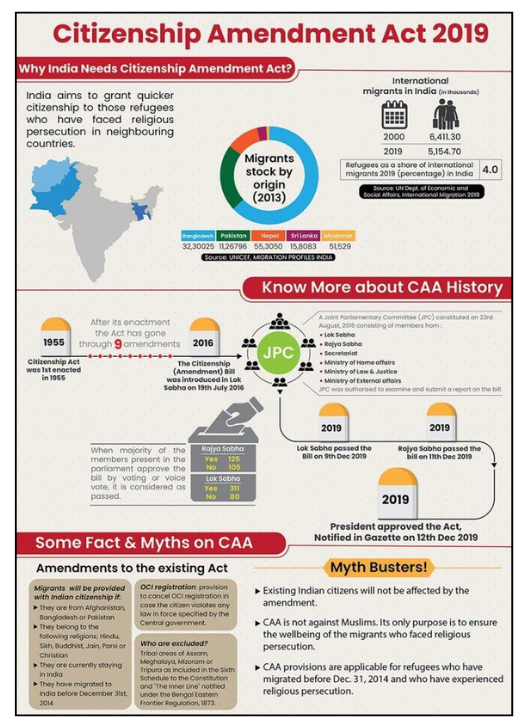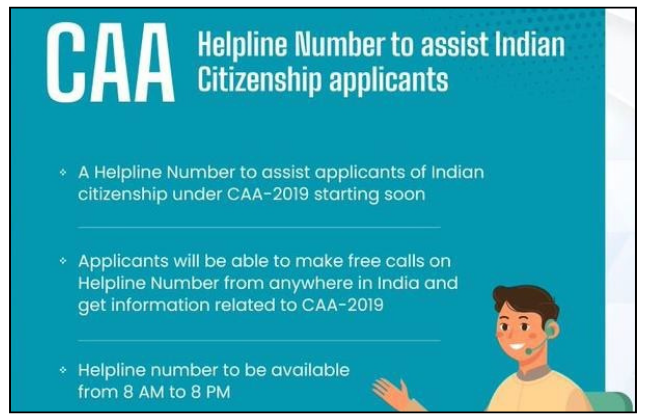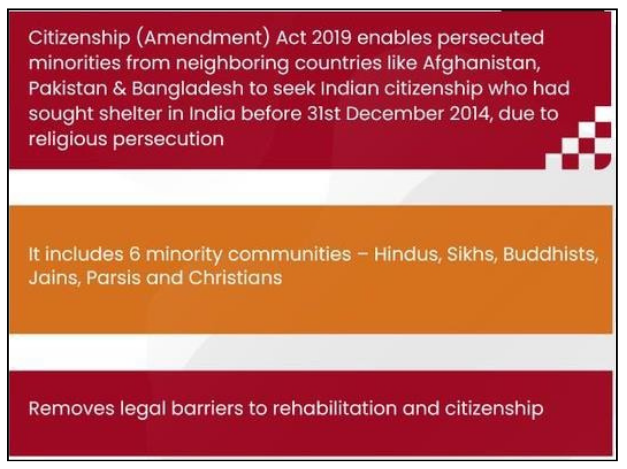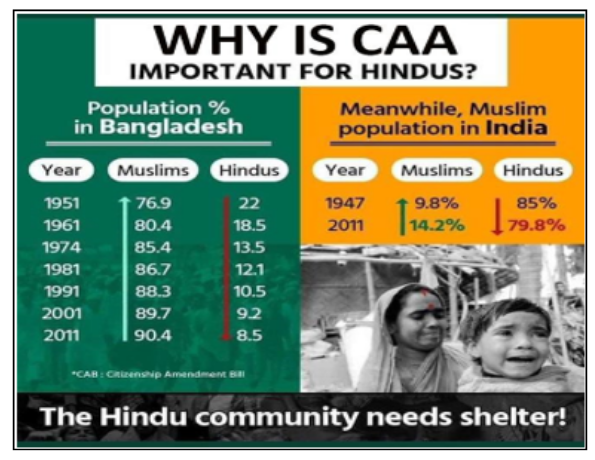The Citizenship (Amendment) Act, 2019
Context:
More than four years after Parliament passed The Citizenship (Amendment) Act, 2019, the Ministry of Home Affairs on March 11th, 2024 notified the Rules to implement the law.1.
Enlist the important features of the CAA?
| Amendment to Citizenship Act 1955 |
|
|---|---|
| Cut off Date |
|
| Residence requirement for naturalization |
|
| Relaxations |
|
| Illegal migrant |
|
| Exemptions |
|
| Sixth Schedule |
|


2.
What are Rules related to CAA notified by the government?
The Centre on March11 notified Rules for The Citizenship Amendment Act (CAA), paving the way for the implementation of CAA four years after it was passed by Parliament in December 2019.
| Who can apply for Citizenship? | 1. Person must be a national of any one of the following countries-
2. Person belongs to any one of the following minority communities in the respective country-
3. Person must have entered India on or before 31st December, 2014. 4. The amendment has relaxed the residence requirement for naturalization of these migrants from 11 years to five. |
|---|---|
| What is the mode for applying? |
|
| What proof is required to establish the country of origin under CAA? |
According to the CAA Rules any of the documents given below can be used as evidences of nationality or citizenship of these countries:
|
| Are Passport and Visa required for applying for citizenship? |
|
| Are any certificates for eighth schedule languages required? |
|
| How will the date of entry into India be established? |
The Rules list 20 documents, any of which would be admissible as proof of date of entry into India. These include:
|
| What List of documents is needed to upload online? |
|
| What is the process of application submission? |
Under section 6B of the Citizenship Act, 1955, individuals seeking registration or naturalization must follow the following process:
|
| Who will be in charge of processing the applications for citizenship? |
|


3.
Which communities are likely to benefit from this Act?
- The CAA will benefit thousands of Hindu, Sikh, Buddhist, Jain, Parsi, or Christian migrants from Pakistan, Bangladesh, and Afghanistan who entered India before December 31, 2014, and seek citizenship of India. This group of people has been living in India illegally or on long-term visas (LTV).
4.
Why was there a need for CAA in India?
- As per UN Department of Economic and Social Affairs, International Migration 2019, there were 6,41,1300 international migrants in India in 2000, whereas their number stood at 5154700 in 2019.
- The percentage of refugees as a share of international migrants in 2019 in India stood at 4%.


5.
What is NRC & how is it different from CAA?
- National Register of Citizens (NRC) is a register prepared after the conduct of the Census of 1951 in respect of each village, showing the houses or holdings in serial order and indicating against each house or holding the number and names of persons staying therein.
- Census of 1951: These registers covered each and every person enumerated during the Census of 1951 and were kept in the offices of Deputy Commissioners and Sub Divisional Officers according to instructions issued by the Government of India in 1951.
- Later these registers were transferred to the Police in the early 1960s.
- Ministry of Home Affairs (MHA): This NRC was prepared under a directive from the Ministry of Home Affairs (MHA).
- Assam: At present, only Assam has such a register and the exercise may be extended to other states as well.
- Nagaland is already creating a similar database known as the Register of Indigenous Inhabitants.
How will the NRC be updated?
- Provisions The NRC will be updated as per the provisions of The Citizenship Act, 1955 and The Citizenship (Registration of Citizens and Issue of National Identity Cards) Rules, 2003.
Eligibility for inclusion in updated NRC
- Persons whose names appear in NRC, 1951.
- Persons whose names appear in the Electoral Rolls up to 24th March (midnight), 1971.
- Descendants of the above persons.
- Persons who came to Assam from Bangladesh between 1st January 1966 and 25th March 1971 and registered themselves with the Foreigner Regional Registration Office (FRRO) and were declared by the Foreigner Tribunal as Indian citizens.
- All Indian Citizens including their children and descendants who have moved to Assam post 24th March 1971 would be eligible for inclusion in the updated NRC on adducing satisfactory proof of residence in any part of the country (outside Assam) as of 24th March 1971.
- Persons who can provide any of the admissible documents issued up to 24th March midnight, 1971.
What is the need for such exercise?
- Identify infiltrators: It effectively suggests bringing legislation that will enable the government to identify infiltrators who have been living in India illegally, detain them and finally deport them where they came from.
- It will target illegal immigrants in India:
- But Hindus, Christians, Sikhs, Buddhists, Jains and Parsis coming from Afghanistan, Pakistan and Bangladesh won’t be affected, if they claim they have arrived in India after fleeing religious persecution.
- 3 countries: It essentially means, if a nationwide NRC is implemented as proposed, any illegal immigrant from other than Pakistan, Afghanistan and Bangladesh, will be affected.
- And as for those three nations, people coming from there who belong to the Muslim community will also be affected as they are not included in the Citizenship Amendment Act.
Is there any link between the CAA and NRC?
- There is no direct link between the CAA and NRC: The Citizenship Amendment Act is meant to help members of the Hindu, Sikh, Buddhist, Jain, Parsi and Christian communities who have migrated from Pakistan, Bangladesh and Afghanistan until December 31, 2014, facing religious persecution, ensuring that they will not be treated as illegal immigrants and given Indian citizenship.
- Approval: The Act got the President of India’s approval in December 2019 after it was passed by both Houses of Parliament.
- Extension: The rules of this Act are yet to be framed and the Centre has sought the extension of the deadline until 2022 in the Supreme Court.
- The NRC: on the other hand is a process of valid Indian identification.
6.
Which countries (other than India) have such rules /Act which give citizenship to selective refugees on the bases of religion/ migrated minorities.
- In 1970, Israel took another historic step by granting automatic citizenship not only to Jews, but also to their non-Jewish children, grandchildren, and spouses, and to the non-Jewish spouses of their children and grandchildren. This addition not only ensured that families would not be broken apart, but also promised a safe haven in Israel for non-Jews subject to persecution because of their Jewish roots.
7.
Enlist some CAA related major protests in India during 2019?

Shaheen Bagh protest:
- The Shaheen Bagh protest was a peaceful sit-in protest in Delhi, India, that began on 15 December 2019 and lasted until 24 March 2020.
- The protest was led by women who blocked a major road at Shaheen Bagh using non-violent resistance 24×7.
- Mainly consisting of Muslim women, the protest began in response to the passage of the Citizenship (Amendment) Act (CAA) on 11 December 2019.

JNU and AMU students protest:
- JNU student unions called for the protest and asked students to hit the street against "undeclared emergency". in Jamia and urged police and government to help students.
- On the similar lines, at Aligarh Muslim University students and police clashed over anti Citizenship Act protest
Delhi riots:
- The 2020 Delhi riots were multiple waves of bloodshed, property destruction, and rioting in North East Delhi, beginning on 23 February 2020 and brought about chiefly by Hindu mobs attacking Muslims.
- The riots had their origin in Jaffrabad, in North East Delhi, where a sit-in by women against India's Citizenship (Amendment) Act, 2019 had been in progress on a stretch of the Seelampur–Jafrabad–Maujpur road, blocking it.

8.
Why are some people protesting against CAA?
| PROTESTER‟S VIEW | PROTESTER‟S ARGUMENTS |
|---|---|
| Violative of Article 14 of the Constitution |
|
| Specifically targets Muslims |
|
| Violating secularism and Basic Structure Doctrine. |
|
| Discriminative law |
|
| Issues wrt to Assam Accord |
|
| Exclusion of other persecuted minorities |
|
| Disrupt Federalism |
|
9.
Can there be any loss of citizenship to any community people due to CAA?
- "I want to tell the minorities of this country that no citizen of the country will lose citizenship due to CAA. The CAA is a law that grants citizenship and does not take away anyone's citizenship. I assure you there is no provision in CAA to snatch anyone's citizenship," – Honorable Home Minister Amit Shah.
10.
What are a few Myths associated with CAA?















11.
Why refugees from only Pakistan, Afghanistan & Bangladesh have been considered but not from other countries included.


12.
How many people will benefit from CAA?

13.
What are some Constitutional provisions related to citizenship?
Constitutional Provisions:
- Citizenship is listed in the Union List under the Constitution and thus is under the exclusive jurisdiction of Parliament.
- The Constitution does not define the term „citizen‟ but details of various categories of persons who are entitled to citizenship are given in Part 2 (Articles 5 to 11).
| ARTICLES | PROVISIONS |
|---|---|
| Article 5 |
|
| Article 6 |
|
| Article 7 |
|
| Article 8 |
|
| Article 9 |
|
| Article 10 |
|
| Article 11 |
|
14.
Was there any Judicial review of CAA?
- The CAA was challenged before the Supreme Court in 2020 by the Indian Union Muslim League (IUML). Since then, more than 200 petitions have been filed and tagged with the IUML’s challenge.
- In October 2022, a Bench comprising then Chief Justice of India U U Lalit and Justices Ravindra Bhat and Hima Kohli passed an order stating that final hearings would begin in December 2022 after CJI Lalit’s retirement. However, the case has not been heard since.
- According to the Supreme Court website, the case is currently listed before a Bench headed by Justice Pankaj Mithal.
15.
Are there any exemptions given to areas under CAA?
- The provisions of the Act will not apply to the tribal areas of Assam, Meghalaya, Mizoram or Tripura as included in the Sixth Schedule to the Constitution and States of Arunachal Pradesh, Mizoram and Nagaland and Manipur that are protected by the Inner Line Permit (ILP).
- This means that those ―illegal‖ migrants who will be deemed Indian citizens through the Act will not be able to settle down in the exempted areas.
Some Questions from this Year and Previous Years Interview Transcripts
Board Gen Raj Shukla sir(2024)
- Why did the introduction of CAA lead to protests? What was the driving force for these protests?
- Does CAA take rights of Indian Muslims?
- What are the concerns with the law?
- What about NRC?
Board Suman Sharma mam (2024)
- Now what is CAA?
Board Dinesh Dasa sir(2024)
- Have you heard of CAA?
- Do you support exclusions of certain communities
- What are the minorities in India
Board RN Choubey sir (2024)
- Should India allow such immigrations? Should we continue accepting them
- There has been a protest regarding CAA?
- Should India continue with this.
Board Manoj Soni sir (2023)
- Difference between NRC and NPR
Board Priti Sudan mam (2023)
- NRC-CAA protests in Assam. You certainly know all the cut off dates etc. I want to know your opinion on CAA.
Board RN Choubey sir (2023)
- What is NRC?
- What is CAA?
- What is the difference between NRC and CAA?
- Should we have NRC for the whole country?
- Why were people opposing the CAA?
Some Questions for QUIZ
Q1.Consider the following statements regarding Citizenship amendment act, 2019
1. It aims to grant citizenship to illegal migrants from Afghanistan, Bhutan and Pakistan.
2. It exempts members of these communities from prosecution under the Foreigners Act of 1946 but not under Passport Act of 1920.
3. It is applicable on immigrants who entered India on or before December 31, 2014.
How many of the above statements are correct? Select the correct answer using the code given below:
(a) Only one
(b) Only two
(c) All three
(d) None
Q2. Consider the following States.
1. Sikkim
2. Manipur
3. Arunachal Pradesh
4. Nagaland
5. Mizoram
How many of the above states are exempted under Citizenship Amendment Act 2019
(a) Only two
(b) Only three
(c) Only four
(d) All five
Q3. Consider the following statements regarding CAA Rules, 2024:-
1. Applicants must provide proof of entry before Dec 31, 2014, only through Visa.
2. Applications will be made to the District Level Committee (DLC), and the final decision will be taken by the Empowered Committee.
3. DLC is under administrative control of the state government.
How many of the above statement(s) is/are correct?
(a) Only one
(b) Only two
(c) All three
(d) None
Some Questions for POLL
Q1. Will implementation of CAA lead to termination of citizenship?
(a) YES
(b) NO
(c) Can’t say
Q2. Can states say no for implementation of CAA?
(a) YES
(b) NO
(c) Can’t say
Q3. Will implementation of CAA impact indigenous communities?
(a) YES
(b) NO
(c) Can’t say